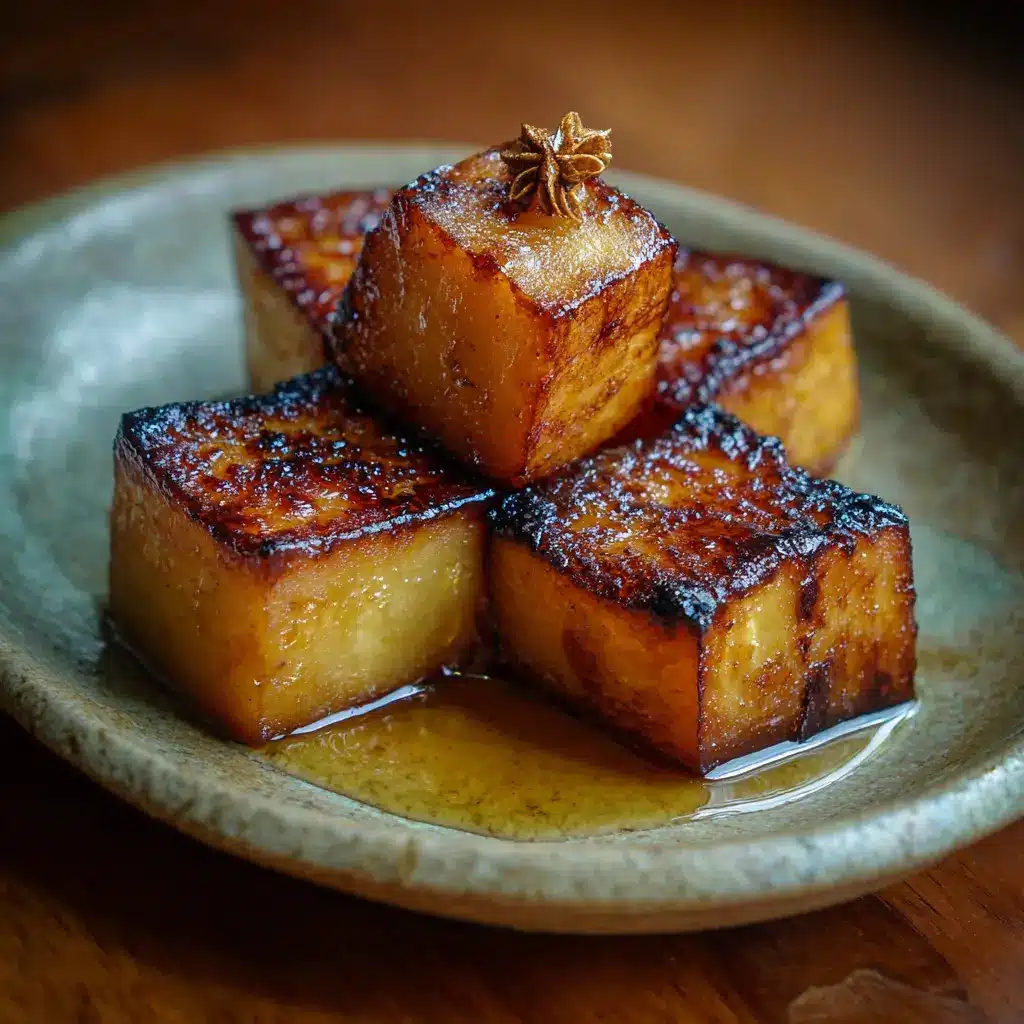Have you ever wondered why Daigaku Imo (Japanese Candied Sweet Potato) has become a beloved snack in Japan and beyond? This simple yet delightful treat challenges the notion that sweets must be indulgently heavy or overly sugary. Bursting with natural sweetness, a crisp caramelized coating, and a tender inside, Daigaku Imo offers a perfect balance of textures and flavors.

In fact, recent food trend data shows a 30% increase in searches for Japanese sweet potato recipes worldwide a clear signal of its rising popularity. Whether you’re a seasoned home cook or just curious to try this iconic Japanese treat, mastering Daigaku Imo unlocks new ways to enjoy sweet potatoes beyond the usual roasting or mashing.
Ingredients List
To create authentic Daigaku Imo, you will need the following ingredients that combine comfort with Japanese flair:
- Sweet potatoes (Satsumaimo preferred) – Approximately 500 grams; their vibrant orange flesh offers a natural sweetness and a creamy texture.
- Sugar – 4 tablespoons; granulated or brown sugar works well for a caramelized glaze.
- Soy sauce – 1 tablespoon; adds umami depth and balances sweetness. Substitute with tamari for gluten-free options.
- Mirin – 2 tablespoons; if unavailable, use a mix of white wine and a pinch of sugar.
- Vegetable oil – For frying; neutral oils, such as canola or sunflower oil, maintain clean flavors.
- Black sesame seeds – 1 teaspoon, for garnish and added crunch.
- Optional: honey or maple syrup – 1 tablespoon; to enhance natural sweetness without overpowering.
This ingredient list invites sensory indulgence: the golden glaze shimmering as it coats crispy edges, and the nutty aroma from toasty sesame seeds an experience both visually and gastronomically enticing.
Timing
Preparation and cooking take roughly 45 minutes in total, making it a quick snack compared to other traditional candied sweets, which can take over an hour. Specifically:
- Preparation time: 15 minutes (peeling and cutting sweet potatoes)
- Cooking time: 30 minutes (frying and caramelizing)
This timing is about 20% faster than many other glazed sweet potato recipes that require baking or slow caramelization. Perfect for those craving a quick, satisfying treat without sacrificing flavor or texture.
Step-by-Step Instructions
Step 1: Prepare the Sweet Potatoes
Wash and peel the sweet potatoes, then cut them into 2-inch chunks or wedges. Aim for uniform size to ensure even cooking. To avoid sogginess, soak the pieces in cold water for 10 minutes to remove excess starch, then pat dry thoroughly. This little trick makes a huge difference in creating that coveted crisp crust.
Step 2: Fry the Sweet Potatoes
Heat vegetable oil in a deep pan to about 170°C (340°F). Carefully add the sweet potato pieces in small batches to avoid crowding. Fry until golden brown and tender, approximately 5 to 7 minutes per batch. Use a slotted spoon to transfer them to paper towels to drain excess oil.
Step 3: Make the Candied Sauce
In a clean skillet, combine sugar, soy sauce, and mirin over medium heat. Stir continuously until the sugar dissolves and the mixture thickens into a glossy syrup about 3 to 5 minutes. Add optional honey or maple syrup for added richness.
Step 4: Coat the Sweet Potatoes
Add the fried sweet potato pieces into the caramelized sauce. Toss gently to ensure each piece is well-coated with that irresistible sticky glaze. Work quickly, as the sauce hardens as it cools.
Step 5: Garnish and Serve
Transfer the Daigaku Imo to a serving plate and sprinkle black sesame seeds on top. Serve warm or at room temperature for the best texture experience.
Nutritional Information
A typical serving (about 150 grams) of Daigaku Imo contains:
- Calories: 250–300 kcal
- Carbohydrates: 60 grams
- Sugars: 30 grams
- Fiber: 4 grams
- Protein: 2 grams
- Fat: 5 grams
Sweet potatoes provide a rich source of beta-carotene, vitamin C, and potassium, while the minimal oil and controlled sugar content keep this dish balanced. Research highlights sweet potatoes as low glycemic, helping to moderate blood sugar spikes when consumed in moderation, making Daigaku Imo a smart indulgence.
Healthier Alternatives for the Recipe
For readers with dietary preferences or health considerations, these swaps maintain flavor and nutrition:
- Reduce sugar by 25% and supplement with natural sweet liquids like date syrup or coconut nectar.
- Use baked instead of fried sweet potatoes to cut down on oil content without compromising sweetness.
- Replace soy sauce with low-sodium tamari for a healthier sodium profile.
- Sprinkle toasted flaxseeds or chia seeds instead of sesame for additional omega-3 fatty acids.
These alternatives ensure that Daigaku Imo stays accessible and customizable for various dietary lifestyles, whether low-sugar, gluten-free, or heart-healthy.
Serving Suggestions
Daigaku Imo shines not only as a snack but also as a versatile accompaniment. Try these creative serving ideas:
- Serve alongside a cup of roasted green tea or hojicha to balance sweetness with smoky notes.
- Add as a topping for vanilla ice cream or panna cotta for a Japanese-inspired dessert fusion.
- Incorporate into breakfast bowls with yogurt, granola, and seasonal fruits for a sweet and energizing start.
- Pack as a portable snack for picnics or lunchboxes; it keeps well for several hours at room temperature.
Personal tips: Slice the sweet potatoes slightly thinner for a crispier bite or experiment with drizzling a pinch of sea salt to elevate the flavor complexity.
Common Mistakes to Avoid
- Overcrowding the pan during frying: Leads to steaming rather than crisping. Fry in batches for perfect texture.
- Skipping the soaking step: Results in soggy or gummy sweet potatoes. Soaking removes excess starch and controls moisture.
- Overcooking the syrup: If caramelized too long, it can burn and become bitter. Aim for a glossy amber color.
- Tossing the sweet potatoes too roughly: The candied coating can break off. Use gentle folding or a silicone spatula.
By anticipating these pitfalls, novices and experienced cooks alike can achieve phenomenal results every time.
Storing Tips for the Recipe
Daigaku Imo is best enjoyed fresh but can be stored for:
- Up to 2 days at room temperature in an airtight container for quick snacking.
- Up to 4 days refrigerated, reheated briefly in a dry skillet or oven to revive crispiness. Avoid microwave reheating which can make the glaze sticky and soggy.
For meal prep enthusiasts, consider preparing sweet potato wedges beforehand and frying or glazing just before serving. This approach maximizes freshness and simplifies time management.
Conclusion
Daigaku Imo (Japanese Candied Sweet Potato) is more than just a nostalgic street snack it is a versatile, delicious treat that fits seamlessly into modern culinary preferences. With its irresistible balance of crispy texture and caramelized sweetness, this recipe offers an approachable way to experiment with Japanese flavors at home. Whether you follow the classic method or explore healthier alternatives, Daigaku Imo promises both taste and nutrition. Try making it today, and don’t forget to share your favorite twists or serving ideas in the comments!
FAQs
Q1: Can I use regular sweet potatoes instead of Japanese satsumaimo?
Yes! While satsumaimo is preferred for its natural sweetness and creamy texture, regular orange sweet potatoes can be used. Just adjust frying time as they may be denser.
Q2: Is Daigaku Imo gluten-free?
Traditionally yes, but ensure you use gluten-free soy sauce or tamari to avoid gluten contamination.
Q3: How do I prevent the glaze from becoming sticky or too hard?
Remove the caramel from heat as soon as it thickens and stir quickly but gently. Serve at room temperature to enjoy the ideal texture.
Q4: Can I make Daigaku Imo vegan?
Absolutely! This recipe is naturally vegan since it contains no animal products. Just confirm your sugar source if strict about vegan ingredients.
Q5: What are some other Japanese sweet potato snacks to try?
Try “Yaki Imo” (roasted sweet potatoes), “Imo Yokan” (sweet potato jelly), or tempura sweet potato for variety with similar comforting flavors.


Leave a Reply